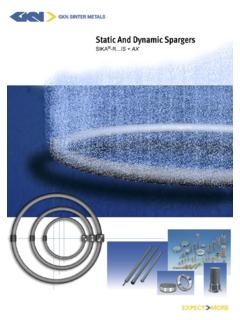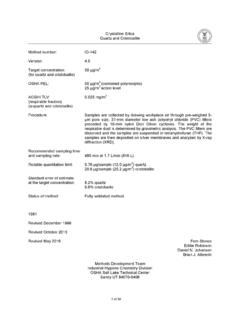Transcription of Recovery Of Rare Earth Elements From Clay Minerals
1 ERES2014: 1st European Rare Earth Resources Conference|Milos|04 07/09/2014 PAGE | 191 Recovery OF RARE Earth Elements FROM clay Minerals Vladimiros G. PAPANGELAKIS1 and Georgiana MOLDOVEANU2 1,2 Department of Chemical Engineering and Applied Chemistry, University of Toronto 200 College Street, Toronto, Canada, M5S 3E5 Abstract Continuous development of advanced technologies has created increasing demand for rare earths Elements (REE), with global emphasis on identifying new alternate sources to ensure adequate supply. clay deposits containing physically adsorbed lanthanides are substantially lower grade than other types of REE mineral resources; however, their abundance in sub tropical regions, existence as surface layers requiring low mining cost, and their high cation exchange capacity make them economically important sources of rare earths.
2 At the University of Toronto we have conducted a systematic study of clay Minerals from various locations. It was found that REE are easily recovered via an ion exchange mechanism during leaching with monovalent salt solutions under ambient conditions, based on a 3:1 stoichiometric ratio between the trivalent lanthanides and the exchange monovalent cation. The present paper reports on the most important findings of this investigation. I. Background Rare earths, also known as lanthanides, are a series of 17 Elements with unique properties that make them essential for the hi tech industry because of their various uses in high strength permanent magnets, lasers, automotive catalytic converters, fiber optics/superconductors, and electronic devices.
3 They are grouped depending on the atomic number, in light rare Earth Elements (REE) La, Ce, Pr, Nd, and middle & heavy REE Sm, Eu, Gd, Tb, Dy, Ho, Er, Tm, Yb, Lu, Y. Because of the ongoing development of new advanced technologies, there is an ever increasing demand for lanthanides in the international markets, with emphasis on identifying new resources to ensure adequate supply for present and future use. World production of REE is dominated by China, the United States and Australia; however, in terms of reserves and resources, China dominates the world potential with reserves estimated to be around 50% of the total while completely leading and controlling the global production at ~ 90%.
4 1 For the last 3 decades, R&D in the field of REE in most of the Western world has slowed down due to the import of these Elements from China. Consequently, the development of specialized extraction, refining and processing technologies, including equipment and training of engineering expertise were allowed to lapse, creating thus a dependence on Chinese supplies. Starting with 2005 China the undisputed leader in both REE innovation and trade, has been restricting yearly export quotas for REE ores in order to have enough resources for its own industries and to gain control over the global market, especially for the heavy and scarcer rare Consequently, the last decade has brought a renewed concerted global drive towards REE research and development, led by USA and Japan, with the dual scope of finding new resources and improving processing/extraction technologies, as summarized by Adachi, Imanaka and ERES2014.
5 1st European Rare Earth Resources Conference|Milos|04 07/09/2014 PAGE | 192 REE are part of many various rock forming Minerals , but the most commercially significant sources, as reviewed by Kanazawa and Kamitani,4 fall into the following categories: 1) Bastnasite, (REE, Ce)(CO3)F, is a magma derived fluorocarbonate mineral containing 65 75 %wt. light rare Earth oxides (REO) and accounts for more than 80% of global REO production. The two major sources in the world for lanthanides are bastnasite deposits at Mountain Pass, California ( ) devoted solely to REE production, and Bayun Obo, Inner Mongolia (China) mined primarily for iron ore and REE as by product.
6 2) Monazite, (REE)PO4 is a light REE phosphate containing 55 65 %wt. REO, associated with granites and beach sands in Australia, Brazil and India. Until about 1965 monazite was the main REE source; since then, the use of monazite has been considerably reduced due to radioactivity caused by thorium and radium. 3) Xenotime (Y,REE)PO4 is an yttrium rich phosphate containing 25 60 %wt. Y2O3 and other heavy REE. It is mainly recovered as by product of mining for titanium, zirconium and tin in Malaysia, Indonesia and Thailand. 4) Weathered Crust Elution deposited Rare Earth Ores (common name: Ion adsorption Clays) are aluminosilicate Minerals ( kaolinite, illite, and smectite) containing %wt.
7 REEs are physically adsorbed at sites of permanent negative charge. The ion adsorption clay deposits are the result of in situ lateritic weathering of rare Earth rich host rocks (granitic or igneous), which lead over geological times to the formation of aluminosilicate clays. These very fine mineral particles have the capability of adsorbing lanthanide ions released/dissolved during weathering. Sub tropical climates present ideal conditions for this lateritic process to occur. The best example of this formation process exists in Southern China (latitudes 24 26 N), where many of such deposits are known to exist, as described by Bao and In spite of their low grade, ion adsorption clays account for ~ 35% of the China s total REE production, according to Yang et Carbonate and phosphate sources, in spite of being high grade, are associated with elevated Recovery costs due to difficulty in mining, separation, beneficiation and need of aggressive conditions to dissolve the REE.
8 For example, bastnasite is generally leached with concentrated H2SO4 or HCl, whereas monazite/xenotime concentrates need to be baked either in 98% H2SO4 or 70% NaOH to render REE soluble. Secondary REE sources include apatite and the so called hard rock deposits such as zircon, titanate, niobate, allanite, eudialyte, gadolinite, but these contain less than 30% REE and require even harsher conditions for breaking down the mineral matrix ( caustic bake followed by acid leaching); the processing of these ores is mainly directed towards extraction of niobium, tantalum and Although ion adsorption clay deposits are substantially lower grade than other types of lanthanide sources, the lower grade is largely offset by the easier mining and processing, costs, and the very low content of radioactive Elements (normally associated with yttrium).
9 These deposits are mined by open pit methods and no ore beneficiation is required. A simple leach using monovalent sulphate or chloride salt solutions at ambient temperature can produce a high grade REO ,9,10 Because of their abundance in surface layers in ERES2014: 1st European Rare Earth Resources Conference|Milos|04 07/09/2014 PAGE | 193 nature, ease of mining and processing, these clays warrant a detailed study as important sources of rare earths. II. Formation of Weathered Crust Elution deposited Rare Earth Ores (Ion adsorption Clays) The ion adsorption clay deposits of REE were first discovered in 1969 in the Jinangxi province (southern China) and declared a novel type of exogenous rare Earth ore.
10 Since then, more deposits were discovered and mined all throughout the South of China, as indicated by Figure 1. Figure 1: Locations of REE bearing ion adsorption clay ores in China5 The formation of this type of ore is due to physical, chemical and biological (microbial) weathering of REE rich granitic and volcanic rocks under warm, humid, slightly acidic conditions in subtropical zones. According to Bao and Zhao,5 the weathering crusts are up to 30 m deep and divided into four layers: (A) An upper humic layer of quartz, organic matter and soil: 0 2 m thick, with very low/nil REE content; (B) a strongly weathered layer enriched in REE: 5 10 m thick with kaolinite, halloysite, quartz and mica; (C) a semi weathered layer: 3 5m thick with kaolinite and sericite; (D) a weakly weathered bottom layer with the same mineral compositions as the host rock.





